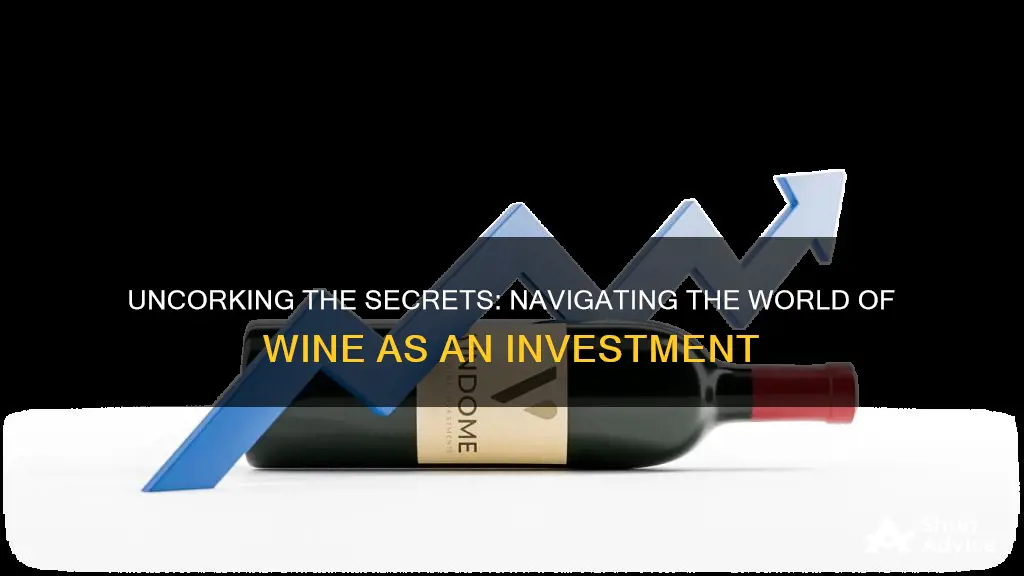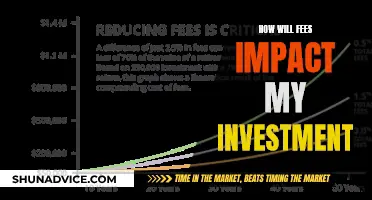
Wine has long been a popular alternative investment, offering diversification and potential returns that aren't tied to the stock market. The fine wine market is a precarious one, requiring specialist knowledge and monetary resources to navigate. However, wine has historically been resistant to recession and has delivered strong returns over the past two decades, outperforming the S&P 500.
The key to successful wine investment is to look for wines with three virtues: quality, rarity, and desirability. These wines will appreciate significantly as they mature and bottles become more difficult to acquire. When investing in wine, it's important to set a budget and conduct thorough research to identify the best investment opportunities.
There are several ways to invest in wine, including buying individual bottles, purchasing wine futures, investing in wine stocks, or using a dedicated platform such as Vinovest or OenoFuture. Wine investing can be a complex and time-consuming pursuit, but it can also be a rewarding one for those with a passion for wine and a long-term investment strategy.
| Characteristics | Values |
|---|---|
| Annual returns | 10-15% typical, but some bottles enjoy remarkable rates of return |
| Returns over time | DRC La Tache (2009) saw returns of over 800% |
| Price range | Bottles can be purchased for as little as $35, but a good investment-grade bottle can cost thousands of dollars |
| Investment platforms | Vinovest, OenoFuture, WineBid, Sotheby's, Christie's |
| Storage | Requires a wine cellar with the right humidity and temperature and limited exposure to light |
| Insurance | Covered by home insurance, or by specialist companies |
| Regions | Bordeaux and Burgundy in France, Rhone Valley, Italy, California, Australia |
| Types | Red wines tend to fetch the highest prices, but there are also white, sparkling and dessert wines |
| Producers | Screaming Eagle, Abreu Vineyard, Schrader Cellars, Lafite-Rothschild, Haut-Brion, Lafleur, Domaine Leroy, Penfolds, Dom Perignon |
What You'll Learn

Wine investment platforms like Vinovest
With Vinovest, investors can skip the hassle of storing wine themselves, as the platform handles insurance, commissions, and authentication in-house. The wine inventory is kept in underground facilities specifically conditioned for wine storage, ensuring the wines are in excellent condition. This also removes the risk of wines ageing prematurely or developing faults due to improper storage.
Through Vinovest, investors can either pick their own wines or use an investment algorithm to decide on bottles and cases. The platform takes into account millions of historical data points, including secondary market pricing, liquidity, producer brand equity, critics' scores, age, and regional vintage strength, to make informed decisions about wines that are likely to increase in value.
Vinovest also ensures the provenance and authenticity of the wines, working directly with wineries to combat the issue of forgery and wine fraud in the industry. When it comes time to sell, the platform works with liquidity channels to help investors offload their wines, or they can simply choose to drink their profits!
The platform's user-friendly interface and branding also make it appealing to a younger generation of investors, modernizing the wine brokering market and opening up wine investing to a wider consumer base.
Bankruptcy: The End of Investing Dreams?
You may want to see also

The benefits of investing in wine
Diversification
Like any other alternative investment, buying wine can provide your portfolio with an excellent source of diversification. Stocks and bonds go through familiar cycles of boom and bust, but collectibles like fine wine deliver investment returns with little to no correlation to traditional assets. Wine offers a unique source of diversification because its value is based on factors unrelated to the performance of the economy, interest rates, corporate earnings, or conventional investor sentiment.
Lower market volatility
Wine experiences lower market volatility. Its value responds to factors such as weather patterns, harvest yields, vintage, and consumer trends, all of which intersect with supply and demand. Because these factors are unrelated to the overall stock market, wine investments can complement a traditional portfolio.
Risk management
Fine wine can help you manage portfolio risk. As a low-volatility investment, fine wine delivers stability and consistent returns. Physical assets are stable sources of value in uncertain times, and fine wine is an effective hedge against inflation and recession. Its performance has proven that it can successfully weather rising prices and economic downturns.
Enhanced potential for returns
Wine can provide enhanced potential for returns. Fine wine has been one of the best-performing assets over the last 30 years, meaning that its value has been increasing over time. The compound annual growth rate since January 1988 has been 12.6%. During the Covid-19 pandemic, leading fine wine indices registered double-digit increases in contrast to the extreme volatility experienced in financial markets. 2021 was a record-breaking year for the fine wine market, which outperformed mainstream equities.
Silver's Investment History: 1800s
You may want to see also

How to sell wine for a profit
Wine can be a great investment, but it's important to know when to sell to make a profit. Here are some tips on how to sell wine for a profit:
Know the Market
Before selling, it's important to understand the market and identify the best time to sell your wine. Wine prices can fluctuate depending on various factors such as supply and demand, vintage, and the performance of specific regions or producers. Keep an eye on market trends and recent sales to determine when your wine is likely to fetch the best price.
Choose the Right Platform
There are several platforms available for selling wine, each with its own advantages and disadvantages. In-person auctions, for example, can provide easy access to buyers but often charge high selling fees. Online wine marketplaces, on the other hand, tend to be more cost-effective and convenient for both sellers and buyers, attracting a wider range of potential purchasers. Consider the fees, target audience, and convenience when selecting a platform.
Store Your Wine Properly
Proper storage is essential to maintaining the quality and value of your wine. Invest in professional storage services that provide optimal conditions for wine maturation, such as controlled temperature and humidity, limited light exposure, and protection from theft or natural disasters. This will ensure your wine remains in pristine condition and help you command a higher price when it's time to sell.
Understand the Factors Affecting Wine Value
The value of wine is influenced by several factors, including age, rarity, and desirability. Older wines with longer ageing potential generally increase in value over time, especially if they are from renowned chateaus or sought-after regions like Bordeaux and Burgundy. Rarity also plays a crucial role, as limited supply and high demand drive up prices. Additionally, the brand equity of the bottle, similar to luxury fashion items, can significantly impact its value.
Consult Experts
When you're ready to sell, consider seeking expert advice to help set competitive and profitable prices for your wine. Services like Vinfolio offer valuation services and can guide you through the process of managing or liquidating your collection. Their expertise can ensure you receive a fair price and maximize your returns.
Diversify Your Portfolio
While individual bottles of wine can be valuable, diversifying your wine portfolio can further increase your chances of making a profit. Invest in a variety of wines from different regions, producers, and styles to minimize the risk of unexpected events like vine diseases or natural disasters that could affect a specific wine or region. A diverse portfolio provides better protection for your investment and can lead to greater profits.
Net Investment's Impact: Exploring Aggregate Demand Sensitivity
You may want to see also

Wine investment vs. stocks
When it comes to investing, the traditional options such as stocks, bonds, and funds are well-known, but an alternative investment option is wine. Wine investment has been a niche market for a long time, but it is gaining traction as a viable option for diversifying one's portfolio. In this article, we will delve into the intricacies of wine investment, compare it to stock investment, and provide insights into the benefits and drawbacks of each.
Understanding Wine Investment
At its core, wine investment involves buying fine wines, typically from renowned châteaus or specific regions, storing them in optimal conditions, and then reselling them later at a profit. The key factors that influence the success of wine investment are quality, rarity, and desirability. Wine investors look for wines with high ratings and those that have consistently performed well over time, such as those from Burgundy and Bordeaux. Additionally, the aging potential of a wine is crucial, as wines with longer lifespans often provide higher returns.
When comparing the performance of wine investment to stocks, it is important to consider benchmark indices. The London International Vintners Exchange (Liv-ex) is the benchmark for the fine wine market, just as the S&P 500 is for U.S. stock performance. Over the two decades from July 2001 to July 2021, the Liv-ex Fine Wine 100 index rose by 270.7%, outperforming the S&P 500 by 8 percentage points without dividends reinvested. However, when dividends were reinvested, the S&P 500 outperformed Liv-ex by 60% during the same period.
It is worth noting that other indices, such as Sotheby's Wine Index, have consistently outperformed the S&P 500 since 2005. Additionally, the Sotheby's Burgundy Market has outperformed the S&P 500 since 2007, while the Sotheby's Bordeaux Market index did so from 2005 to 2019. These comparisons highlight the potential for wine investments to offer lucrative returns.
Advantages of Wine Investment
Wine investment offers unique advantages that set it apart from traditional stock investments:
- Diversification: Wine provides a source of diversification as its value is based on factors such as weather patterns, harvest yields, vintage, and consumer trends, which are unrelated to the performance of the stock market.
- Lower Volatility: Wine experiences lower market volatility compared to stocks, providing a more stable investment option.
- Risk Management: Investing in fine wine can help manage portfolio risk by reducing exposure to traditional asset classes.
- Enhanced Return Potential: Wine has the potential to deliver higher returns, especially when investing in rare and sought-after vintages.
- Value Preservation: Wine may preserve its value during market contractions or recessions, providing a hedge against economic downturns.
Disadvantages of Wine Investment
However, wine investment also comes with certain drawbacks that investors should consider:
- Higher Costs: Wine investment entails higher initial costs, buyer's premiums, shipping costs, storage costs, insurance, and other fees, which can add up quickly.
- Long Holding Period: Fine wine often takes seven to ten years or longer to reach its maximum value, requiring a long-term commitment from investors.
- Expertise Required: Wine is a complex asset, and successful investment requires extensive knowledge about vintages, producers, regions, and market trends.
- Limited Liquidity: Wine is a less liquid asset compared to stocks, and investors may need to hold onto their bottles for extended periods before finding buyers.
Wine investment offers an alternative to traditional stock investments, providing diversification and the potential for lucrative returns. However, it also comes with higher costs, longer holding periods, and a need for specialized knowledge. Investors considering wine as an investment option should carefully weigh the advantages and disadvantages before making any decisions.
Invest in These 3 Things Now
You may want to see also

Wine storage
Location and Environment
Optimal wine storage involves maintaining consistent environmental conditions. Wine should be kept in a dark, cool, and humid environment to preserve its quality. Avoid exposing the bottles to direct sunlight or harsh artificial lighting, as UV rays can damage the wine. The ideal temperature for wine storage is between 12°C to 14°C (54°F to 57°F). Maintaining a cool temperature slows down the ageing process, allowing the wine to develop more complex flavours over time. Additionally, aim for a humidity level of around 50-70% to prevent the corks from drying out and cracking.
Storage Facilities
There are several options for wine storage facilities. Some investors opt for private cellars, but professional storage services are often recommended. These services offer specialised climate-controlled rooms that maintain the ideal temperature and humidity levels for wine storage. They also provide additional security measures to protect your investment from theft or damage caused by natural disasters such as fires or earthquakes. Consider using professional storage services, especially if you plan to invest in high-value wines or build a substantial collection.
Bottle Orientation
The way you position your wine bottles during storage can impact the wine's quality. For wines with natural corks, it is essential to store them on their sides, ensuring that the cork remains in contact with the wine. This prevents the cork from drying out and shrinking, which could allow air into the bottle and cause oxidation, spoiling the wine. However, if the bottles have screw caps or synthetic corks, storage orientation is less critical, and they can be stored upright.
Bottle Movement
Minimise the movement of wine bottles during storage. Constant vibration or agitation can disturb the sediment in the wine, affecting its ageing process and overall quality. Ensure that your storage area is relatively stable and free from frequent vibrations or disturbances.
Bottle Condition and Inspection
Regularly inspect the condition of your wine bottles to ensure that they remain sealed and undamaged. Check for any signs of leakage, mould, or damage to the labels. Additionally, keep the bottles free from strong odours, as wine can absorb nearby scents over time, affecting its flavour.
Security and Insurance
Consider the security measures in place at your chosen storage facility. Protect your investment by ensuring that the storage area is secure from unauthorised access and potential theft. Additionally, insurance is a vital aspect of wine storage. Insuring your wine collection provides financial protection in the event of theft, damage, or natural disasters.
By following these guidelines and considerations, you can effectively store your wine investments, preserving and potentially increasing their value over time. Proper wine storage is a critical component of successful wine investing, ensuring the quality and longevity of your chosen vintages.
Mortgages and Markets: Navigating the Investment Landscape
You may want to see also
Frequently asked questions
Wine investing involves buying fine wine, storing it, and reselling it later for a profit. Wine investors look for wines with three virtues: quality, rarity, and desirability.
Wine investors buy bottles of wine that have the potential to gain value over time. These are usually wines that are long-lasting, rare, and in-demand. The wines are then stored in optimal conditions to preserve them. Once the wines have matured, they can be sold for a profit.
Wines from Bordeaux and Burgundy in France have traditionally been popular for investment. However, today, you can also invest in wines from the Rhone Valley in France, Italy, California in the US, and Australia. Some examples of fine wine prices include: 1992 Screaming Eagle Cabernet Sauvignon ($500,000) and 1945 Château Mouton-Rothschild (Jeroboam) ($310,700).
The amount of money you need to start investing in wine can vary. Some sources suggest that an initial investment budget of $10,000 is a good starting point for building a wine investment collection. However, there are platforms like Vinovest that allow you to start investing in wine with as little as $1,000.
Wine investing can provide diversification to your portfolio and has the potential for strong returns. Wine has historically been resistant to recession and has low correlation with the stock market. Additionally, wine is a tangible asset that has been valuable in different parts of the world for thousands of years.







